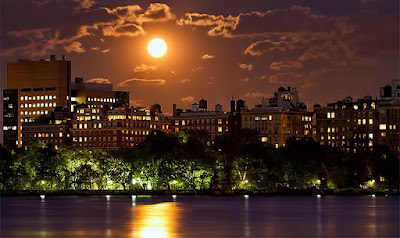Eclipse: Super flower blood moon in New York
Finally, a cause to stay up late on Sunday: a total lunar eclipse.
The Earth's shadow will cover the moon during optimum viewing hours on the night of May 15 for lunar observers across the United States. Those on the East Coast will be able to see our natural satellite begin to turn an odd copper-red color at 11:30 p.m. Eastern time during one of the longest lunar eclipses in recent memory.
"This is a fantastic viewing opportunity for pretty much the entire North America," said Madhulika Guhathakurta, an astrophysicist at NASA's Goddard Space Flight Center in Greenbelt, Md.
When and where can I observe the lunar eclipse?
The eclipse will be visible across most of the globe, including the Americas, much of Europe and Africa, and parts of the Pacific. According to Joseph Rao, an associate astronomer at the Hayden Planetarium in New York, approximately 2.7 billion people should be able to see at least a portion of the eclipse.
The left half of the moon should become dusky shortly after sunset. The big spectacle, though, begins around 10:28 p.m. Eastern time, when the moon enters the umbra, Earth's center shadow. At that point, it will appear as if something has taken a bite out of the moon.
When the moon is about three-quarters of the way into the umbra, it should begin to glow reddishly, "like your electric range right when the coils begin to glow," Mr. Rao explained.
The moon will be in the deepest area of the Earth's shadow at 11:29 p.m., and the complete eclipse will begin in earnest. The eclipse will peak shortly after midnight, at approximately 12:12 a.m., and will remain copper in color until after 1 a.m. At 1:56 a.m., the moon will depart the umbra, restoring its iridescent tint as the work week begins.
Viewers in the west won't have to stay up as late, with the best views of the red moon beginning about 8:29 p.m. The total eclipse will end at 9:54 p.m. Pacific time, with the peak arriving shortly before 9:12 p.m. Observers in Hawaii will see the moon rise as a reddish ball, while those in Europe and Africa will see the reverse effect, with the moon dropping below the horizon during the complete eclipse.
Totality — when the moon is blood red and in the darkest shadow — lasts longer than typical, nearly 1 hour and 25 minutes, giving skywatchers plenty of time to enjoy the spectacle.
According to Mr. Rao, this is the longest complete lunar eclipse visible for much of the United States since August 1989.
Weather forecasts in New York predicted a 40% probability of rain on Sunday night, with circumstances remaining largely gloomy for several hours before the eclipse's totality.
If you are unable to see the eclipse due to inclement weather, NASA will be livestreaming the event on their website. Another webcast will be hosted via the Slooh online telescope.
What will I need to see the eclipse?
Viewing the fantastic scene does not require any special equipment. Simply gaze up and spot the moon at night if the weather is clear. Darker sky are preferable for capturing the subtleties of the moon's color change, but city dwellers will also have excellent views of the eclipse.
"Because it is happening at such a convenient time, I would recommend attempting to observe it from beginning to conclusion," Dr. Guhathakurta advised.
She suggested that binoculars or a backyard telescope will help bring out the crimson color. Viewers with such tools should be able to observe Earth's shadow pass over craters, valleys, and mountains on the moon, causing them to take on a scarlet tint.
Dr. Guhathakurta suggested that those interested can familiarize themselves with details of the event beforehand and learn more about lunar topography by visiting NASA's Goddard center, which hosts maps and visualizations of both the moon during the eclipse and where on Earth the eclipse will be visible.














0 comments